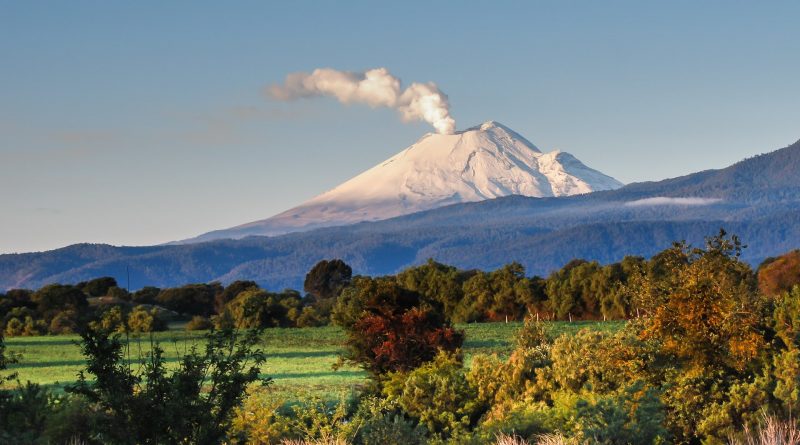Volcano Popocatepetl
The Popocatépetl volcano is the second largest volcano in North America. It is 5426 metres high, while the Orizaba volcano, also in Mexico, reaches 5636 metres. It is located 70 km southeast of Mexico City and 45 km southwest of Pueblo. The crater has a depth of approximately 250-450 metres.
The volcano’s name in Nahuatl means Smoky Hill. Popocatepetl is popularly known as Popo or El Popo.
Popo is one of the most active volcanoes in Mexico, with 15 eruptions since the arrival of the Spanish in 1519. The ancient Aztecs, who lived in central Mexico, wrote about eruptions in 1347 and 1354. Most of the eruptions over the past 600 years have been relatively mild, with ash thrown a few kilometres away.
The last major eruption of the Popocatépetl volcano was in 2011. The volcano is constantly monitored, with more than 20 million people living within a 70 km radius, in order to predict future eruptions.
Characteristics of a restless volcano
“The volcano’s name is El Popo, translated from the language of the ancient Aztecs. The landmark is located 55 kilometres from Mexico City and 45 kilometres from the Mexican city of Puebla. Although the volcano demonstrated its formidable power to the inhabitants of nearby settlements as early as 820 AD, from time to time its activity is clearly visible.
Interestingly, the entire surface of the volcanic slopes varies in appearance. In the lower part there are dense forests, consisting of spruce and pine trees. Behind this dense green carpet comes a dead zone covered with stones and boulders. And at the top there are glaciers that never melt.
The soil near the volcano is very nutritious thanks to its fertilisation with ash. The famous yew tree, the so-called “Thule tree”, grows here. The yew is protected by the state. Its huge trunk weighs up to 550 tons.
Brief history of eruptions
The Popocatépetl volcano is active and quite active by volcanic standards. It has erupted more than 20 times in the last 500 years. Even in the last 70 years there has been an increase in volcanic activity. In 1947 there was a powerful eruption. In December 1994, the volcano spewed out gases and ash that were carried 25 km around. In December 2005, another explosion occurred at the volcano’s vent, spewing smoke and ash 3 km into the air. The eruption was accompanied by lava flows. In April 2012, superheated rock fragments were reported to be ejected into the air from the volcano. Emissions of ash and water vapour were repeated 15 times in a single day. In May 2013, the volcano again emitted ash 3 km high. In March 2016, a 2 km high ash plume was released. This caused a 12-kilometre-long dark ring to form around the summit. And in April of the same year, Popocatépetl erupted, spewing lava and volcanic rocks.
Flights from nearby airports even had to be cancelled at times. The Popocatépetl volcano can be seen from several tens of kilometres away if the weather is good and clear. It rises massively above the surrounding landscape, creating a magnificent landscape.
Because it is constantly smoking, local Indians have long referred to it as “the smoking mountain”. This is how “Popocatepetl” translates. “Popoca” means “smoke” and “tepetl” means “mountain” or “hill”. Since ancient times, people have generally assigned mythical properties to prominent natural objects. This was especially true of mountains and volcanoes. And if the volcano is active and constantly smoking, legends and myths are assured for it. The Popocatépetl volcano was not spared this fate. A closer look at the map (or better still at a live one) reveals a second volcano called Istaxihuatl 17 kilometres to the north. It is slightly lower than Popocatepetl. It is 5,230 metres high (the third highest in Mexico).
Both volcanoes are located in the Istaxihuatl-Popocatepetl National Park. Both volcanoes share the same ancient legend.
A legend for two
Version one. In ancient times, a strong Indian tribe lived in these places. As supposed, the tribe had a chief, and he had a beautiful daughter named Istaxiuatl (translated as “White Woman”). The tribe had a strong, young and handsome warrior (what else could he be) whose name was Popocatepetl. The chief’s daughter and the warrior fell in love. But the father was opposed to their union, as he was going to give his daughter in marriage to one of the important men of his tribe. He sent Popocatepetl to fight a war with another tribe in Oaxaca (now one of the states of Mexico). The war was fierce, and the chief expected the brave warrior to die there. Without waiting for reliable information, the father told his daughter that her fiancé had died in battle. Istaxiuatl could not bear the news and died of grief. But when, unexpectedly, Popocatépetl returned home alive and learned of his beloved’s death, he took her body in his arms and went with him far into the mountains. After burying Istaxiwatl, the warrior himself soon died of longing. The gods saw it all, and in honour of such great love, they covered the bodies of the lovers with blankets, which later became two high mountains covered with snow.
The second version. According to the second version, the legend has a slightly different setting. The beginning is the same as in the previous version, but the continuation is different. The chieftain turns out to have nothing to do with it. In fact, there was another man who looked after his daughter besides the warrior. He was scheming and trying in every way to hinder the love of Istaxiwatl and Popocatepetl. It was at his request that the chief sent Popocatepetl to war. The new suitor told the girl that her betrothed had been killed and, taking advantage of Istaxiwatl’s state of distress, persuaded her to marry him. And so it happened. The girl was very unhappy and when she found out that her lover was alive, she could not bear her unwitting betrayal and committed suicide. Popocatepetl heard what had happened and was furious. Furious with everyone, the young man took the girl’s body into the mountains and built a large pyramid-shaped tomb for her. He built a second pyramid for himself and lived there until he died of homesickness. This is how both mountains came into being. The periodic eruptions of the volcano express Popocatepetl’s revenge against the people.
You may also like:

